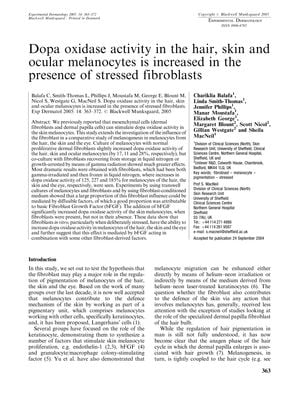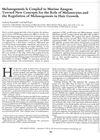Dopa Oxidase Activity in Hair, Skin, and Ocular Melanocytes Is Increased in the Presence of Stressed Fibroblasts
April 2005
in “
Experimental Dermatology
”

TLDR Stressed fibroblasts greatly increase melanin production in hair, skin, and eye cells, mainly due to a growth factor called bFGF.
The study by Balafa et al. from 2005 explored how fibroblasts affect dopa oxidase activity, a marker of melanin production, in melanocytes from hair, skin, and eyes. Normal fibroblasts slightly increased dopa oxidase activity, but stressed fibroblasts (recovered from liquid nitrogen or irradiated) significantly enhanced this activity (by 125% in hair, 227% in skin, and 185% in ocular melanocytes). The research indicated that basic Fibroblast Growth Factor (bFGF) and possibly other diffusible factors from fibroblasts are responsible for this stimulation. Neutralizing antibodies against bFGF and Hepatocyte Growth Factor (HGF) showed that these factors contribute to the increased dopa oxidase activity, with bFGF having a more substantial role. The study concluded that stressed fibroblasts can greatly stimulate melanogenic activity in melanocytes, mediated by bFGF and other factors. The number of melanocytes or experiments conducted was not specified in the summary provided.

